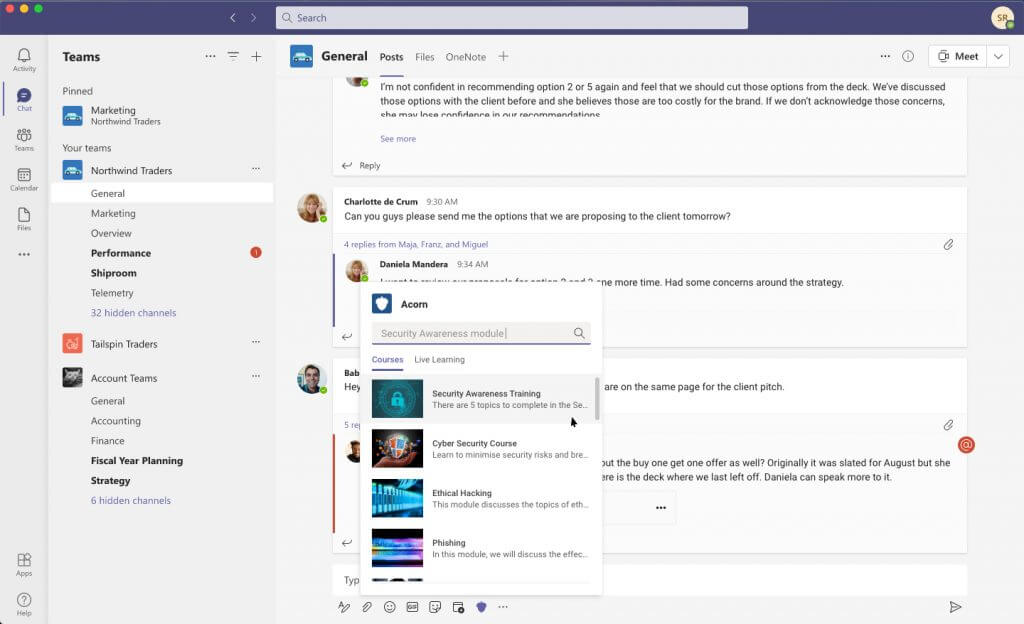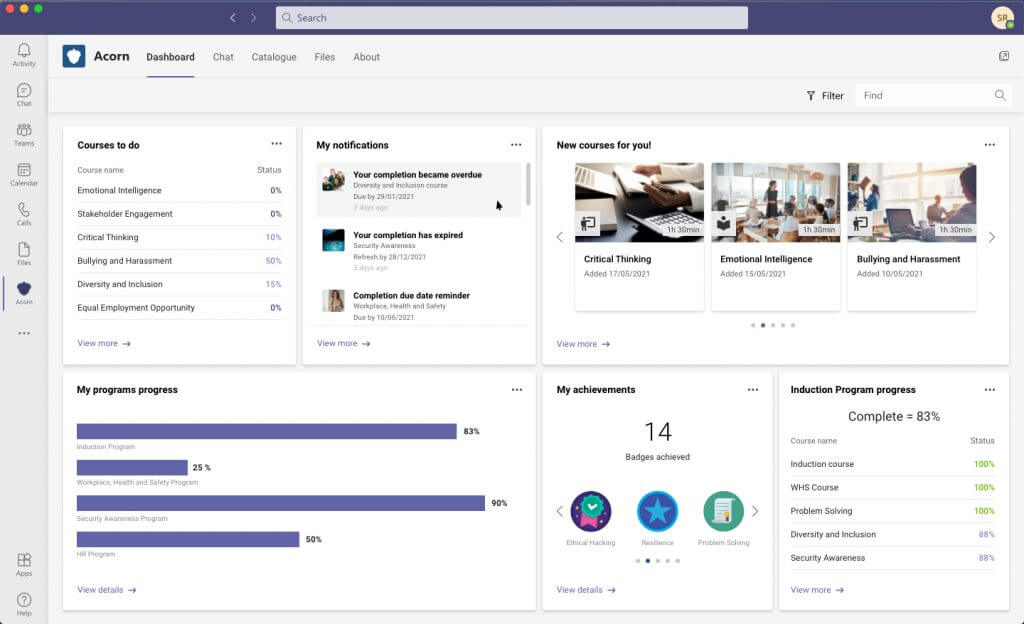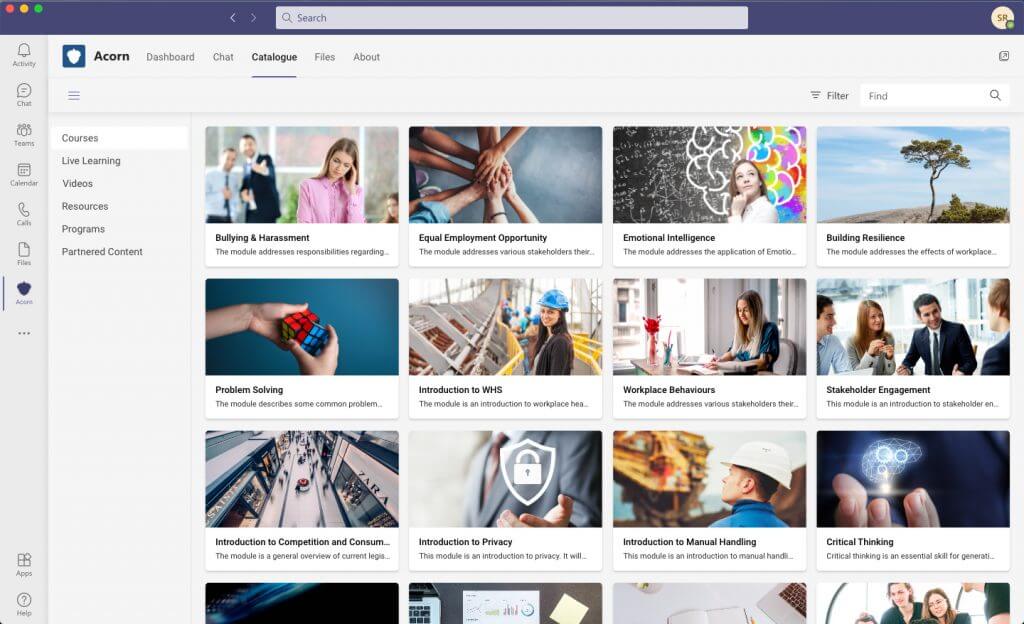Why You Should Integrate Microsoft Teams & Your LMS

It’ll elevate and streamline the learning experience – but not all providers can offer this integration.
A factor not everyone considers when procuring a learning management system (LMS) is that it happily plays well with others. In fact, there’s one other system it works very well with—and you’re probably already using it in your organisation. Yes, we’re talking about Microsoft Teams.
Just how can Microsoft’s collaboration platform and your learning management system complement each other? The power of convenience.
Both are seeking to increase productivity and engagement, which means a Microsoft Teams-LMS integration puts learning where your employees are already converging to empower your workforce activities.
In this article, we’ll show you just why you should consider a Microsoft Teams-LMS integration to create a better user experience for learners, admin and IT personnel alike.
Employee training in the new world of hybrid work
Before we get into the nitty gritty, let’s talk some general shop. The workforce has experienced serious disruption in the last couple of years. A hybrid work environment is no longer a nice-to-have—it’s a must if you want to retain talent.
Microsoft’s 2021 Work Trend Index found 46% of employees considered leaving their employers in the last year, because they know they can work flexibly elsewhere. Gartner noted in their 2021 Future of Work Report that radical flexibility—i.e., the notion of focusing on outcomes, not activity metrics—drives better performance. This includes offering flexible work experiences and enabling intentional collaboration.
So, what does this have to do with an integration between your collaboration hub and learning management system?
In the same way hybrid work is important for retaining your future workforce, professional development is crucial to supporting an agile and adaptable workforce that can meet the changing landscape of your industry. Which is why placing learning right where your employees are already talking, meeting and working is the best way to approach upskilling in this new world of work.
The integration we’re talking about facilitates faster knowledge sharing, better data collection and more personalised performance enablement. It’s also immune to those major disruptions we talked about before, meaning that your employees can collaborate, work and learn in the one place no matter if they’re in the office or working remotely. Which really means your organisation isn’t susceptible to loss of profits, layoffs or any other pitfalls of sudden disruption.
Not convinced? Let’s dive deeper.
The main benefits of a Microsoft Teams-LMS integration
A learning management system houses all your learning data (and some of your people data, thanks to HRIS integrations). Microsoft Teams acts as your communication hub. Combining the two gives you advantages at three distinct steps of the learning process:
- Content discovery
- Accessibility
- Collaboration
Content discovery
Learning content discovery can be a challenge in engaging learners. Even with astute search and organisation functionality, an LMS like Acorn has thousands upon thousands of content offerings—both custom made by users and pulled from third party content providers. When investing in creating or purchasing licenses for content, you want to ensure that learners can and will find the content they need.
For example: Imagine talking to a co-worker about a course you’ve taken that you found incredibly beneficial. Or discussing learning opportunities with someone in a junior role. Can you remember the title of a particular program? If not, you’ve got to go into the LMS and search for it. That’s a whole bunch of unnecessary steps that’ll likely stop many people from actually doing it.
When you integrate your instance of Microsoft Teams instance with an LMS, however, you can simply open the LMS tab, search for the title, and a chatbot will offer results. Then you can copy that link and paste it directly into your chat with that co-worker, where they can open the content directly into their Microsoft Teams window. You can even ask for recommendations for content based on certain topics or skills. Convenient content discovery like this makes learning easy, engaging, and accessible—by delivering learning where employees are already converging.
Accessibility
Proximity matters in learning and development and online experiences. Today’s workforce is overwhelmed, disrupted and untethered, even with technology. Ever heard of the 1-Click Rule? It posits that every click or interaction should get a user as close to their goal as possible while minimising any noise. Basically, if a user has to click around to find something, they simply won’t do it. Switching between systems is a fairly universal office experience, which is why it grinds so many people’s gears.
Similarly, the harder it is to access coursework, the more likely people will procrastinate doing it or just forget about it. Most people are working flexibly, remotely, or part-time, which makes access through a system they’re already using day-to-day all the more important. So, in the same way being able to search for LMS content within Microsoft Teams makes content discovery more enticing, being able to complete courses within the app makes learning all the more engaging.

Collaboration
The Microsoft Teams ethos is to “bring people together”. You’re likely primarily using it for chatting and videoconferencing. This means it’s in prime position to encourage better collaboration when it comes to learning. Social learning is proven to:
- Develop higher-order thinking
- Boost confidence
- Validate comprehension through knowledge sharing
- Improve interpersonal skills
- Increase experiential learning in the workplace.
Ergo, get your people talking about what they’re studying. Double ergo, put learning in the place they’re already talking, so it makes it all the more easier to work on group assignments, chat directly with instructors, facilitate group-work and ultimately create social capital and value in your learning initiatives.
Want to see Acorn PLMS & Microsoft Teams in action?
Hit the book a free demo button here, take seconds to fill in your details, and find out how Acorn can help you succeed.
Benefits for learners
Building engagement amongst remote users is no mean feat. They don’t get the option of face-to-face delivery (if it’s even on the table), and oftentimes learning can fall to the wayside when they’re bouncing between the different software, websites and platforms they have to use for work. (Plus, the home and life priorities they’re balancing, too.) Not to mention, the general way in which employees work today is disrupted, untethered and full of distractions. Typically, employees have only 24 minutes or 1% of their workweek to focus on training.
In a remote learning environment, Microsoft Teams is the path of least deviation for your learners. It delivers learning where employees already are. Let’s think about it in a slightly different way. There are a few crucial parts of the digital learning experience:
- Lectures & tutorials
- Forums & discussions
By choosing an LMS you can access through Microsoft Teams, you and your users can view meetings, events, assignments, content, calendars and due dates in the same app. Say a number of learners have to work on a collaborative assignment, but they’re all in different locations and working on the assignment at different times. If they work on separate documents, one person will have to compile everyone’s work at the end. If they work on the same document, they all have to wait for it to be passed along, which wastes time and could see different versions crop up if one learner decides to create their own copy. Within Microsoft Teams, they can:
- Share and edit the same document, at the same time, directly in the Microsoft Teams app.
- Create a group chat to the side of an assignment, form their own team, or meet in class channels.
- Even have group calls or meetings to discuss coursework.
- Be instantly notified of one another’s edits as well as the due date.
- View their coursework progress in real time.
- Work on courses on their tablets, personal laptops or mobiles, so they’re not restricted to in-office learning.

Essentially, you want a Microsoft Teams integration with your LMS because…
It becomes your employee value proposition on two counts. Firstly: Providing accessible and personalised opportunities for development leads to more positive and sustainable employee experiences. Secondly: This integration will remove many of the real-life obstacles to learning your users likely experience. Instead of adding another system to users’ repertoire, you’re making ones they already use more useful, and therefore the experience of using them more meaningful.
Benefits for admin & instructors
Consider how Microsoft Teams is designed to increase productivity and collaboration between teams of people. Then think about how an LMS like Acorn is platform for an ongoing flow of learning, training and enabling workforce plans. And lastly, we’d like you to consider that the learner experience is likely via the internet or an app. The flow of learning and work often cross paths, which is where a Microsoft Teams-LMS integration comes in.
When an LMS resides within Microsoft Teams, admin can:
- Create collaborative channels (aka “classrooms”) to easily notify learners and monitor forums
- View the content library, search content via keyword queries, and send content directly to users through chat
- View, edit and even grade assessments
- Enable in-app notifications to ensure users don’t miss due dates for all assessments, but particularly compliance training
- Schedule live events which are then plugged into their Microsoft Teams calendar, as well as host meetings.

This doubles the power of automation you’ve got: Not only can you create set and forget courses, emails, notifications and reminders within your LMS, but you can enable them within in Microsoft Teams and save on replication of effort. While many admin privileges like reporting will still exist within the LMS itself, you can more easily monitor individual progress and real-time engagement, as well as provide live feedback and grades on assessments.
Essentially, you want a Microsoft Teams integration with your LMS because…
Admin have one hub to rule them all. Your admin, instructors and facilitators already have to go through a plethora of systems (Microsoft Teams, Office 365, time tracking, HR, payroll…) before they even get to your LMS. This makes it all the more enticing to simplify the peripheral processes they manage around learning in the one space they’re using every day.
In conclusion: You need a Microsoft Teams-LMS integration
Make no mistake, Microsoft Teams is not a replacement for your LMS—nor is an LMS a replacement for your everyday communication channels. But together? You’ve got a force for organisational good with an LMS in Microsoft Teams.
In this new world of hybrid work, a Microsoft Teams-LMS integration consolidates learning, learning for work, and work itself in one place. This drives innovation through intentional collaboration, without negating the need for Microsoft Teams and an LMS as independent systems. Advanced functionality such as reporting and content creation still exist solely in the LMS, while Microsoft Teams remains your core platform for work-related messaging, video calls and calendar appointments.
The real reason you want a Microsoft Teams-LMS integration is to remove limitations and many of the tangential processes that might distract your users (both learners and admin) from effectively engaging with learning programs. While making learning more convenient for remote workforces, you’re also ensuring it’s always one click away in learners’ minds.
If you’d like to learn more about how you can integrate your Acorn LMS tenancy with Microsoft Teams, give us a call today.